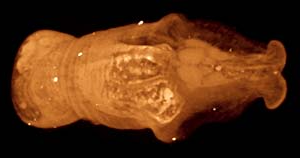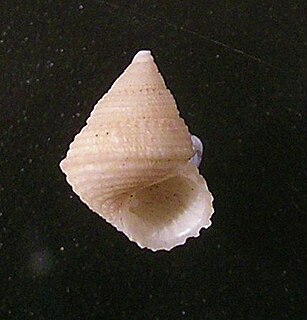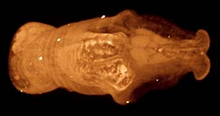
The Chaetognatha or chaetognaths are a phylum of predatory marine worms that are a major component of plankton worldwide. Commonly known as arrow worms, about 20% of the known Chaetognatha species are benthic, and can attach to algae and rocks. They are found in all marine waters, from surface tropical waters and shallow tide pools to the deep sea and polar regions. Most chaetognaths are transparent and are torpedo shaped, but some deep-sea species are orange. They range in size from 2 to 120 millimetres.

Priapulida, sometimes referred to as penis worms, is a phylum of unsegmented marine worms. The name of the phylum relates to the Greek god of fertility, because their general shape and their extensible spiny introvert (eversible) proboscis may recall the shape of a human penis. They live in the mud and in comparatively shallow waters up to 90 metres (300 ft) deep. Some species show a remarkable tolerance for hydrogen sulfide and anoxia. They can be quite abundant in some areas. In an Alaskan bay as many as 85 adult individuals of Priapulus caudatus per square meter has been recorded, while the density of its larvae can be as high as 58,000 per square meter.
The radula is an anatomical structure used by mollusks for feeding, sometimes compared to a tongue. It is a minutely toothed, chitinous ribbon, which is typically used for scraping or cutting food before the food enters the esophagus. The radula is unique to the molluscs, and is found in every class of mollusc except the bivalves, which instead use cilia, waving filaments that bring minute organisms to the mouth.

Limpets are a group of aquatic snails that exhibit a conical shell shape (patelliform) and a strong, muscular foot. Limpets are members of the class Gastropoda, but are polyphyletic, meaning the various groups called "limpets" descended independently from different ancestral gastropods. This general category of conical shell is known as "patelliform" (dish-shaped). All members of the large and ancient marine clade Patellogastropoda are limpets. Within that clade, the members of the Patellidae family in particular are often referred to as "true limpets".

Aplacophora is a presumably paraphyletic taxon. This is a class of small, deep-water, exclusively benthic, marine molluscs found in all oceans of the world.

The Solenogastres, common name the solenogasters, are one class of small, worm-like, shell-less molluscs (Aplacophora), the other class being the Caudofoveata (Chaetodermomorpha).

Odontogriphus is a genus of soft-bodied animals known from middle Cambrian Lagerstätte. Reaching as much as 12.5 centimetres (4.9 in) in length, Odontogriphus is a flat, oval bilaterian which apparently had a single muscular foot, and a "shell" on its back that was moderately rigid but of a material unsuited to fossilization.

Acochlidiacea, common name acochlidians, are a taxonomic clade of very unusual sea snails and sea and freshwater slugs, aquatic gastropod mollusks within the large clade Heterobranchia. Acochlidia is a variant spelling.

Seguenzioidea is a superfamily of minute to medium-sized sea snails, marine gastropod mollusks in the clade Vetigastropoda.

Cymbula adansonii is a species of sea snail, a true limpet, a marine gastropod mollusk in the family Patellidae. It is one of the several families of true limpets. Marine gastropods, colloquially classified as snails and slugs, encompass the entire class of invertebrates in the Mollusca phylum. True limpets, are pelagic snails within the Patellidae family.
Notomenia is a genus of solenogasters, shell-less, worm-like, marinemollusks. In this genus the animal bears non-mineralized sclerites. This genus is the sole representative of the family Notomeniidae, and has secondarily reduced its radula, which is vestigial.
Anamenia is a genus of cavibelonian solenogaster, a kind of shell-less, worm-like mollusk.

Kruppomenia is a genus of solenogaster, a kind of shell-less, worm-like, marine mollusk.
Helicoradomenia is a genus of solenogasters, shell-less, worm-like mollusks.
Cyclomenia is a genus of solenogaster, a kind of shell-less, worm-like mollusk.

Rhopalomenia is a genus of solenogasters, shell-less, worm-like, marine mollusks.

Epimenia is a genus of cavibelonian solenogasters, a kind of shell-less, worm-like mollusks.

Kruppomenia is a family of solenogaster, a kind of shell-less, worm-like, marine mollusk.
Lonchoderma is a genus of molluscs belonging to the family Prochaetodermatidae.
Claviderma is a genus of molluscs belonging to the family Prochaetodermatidae.











